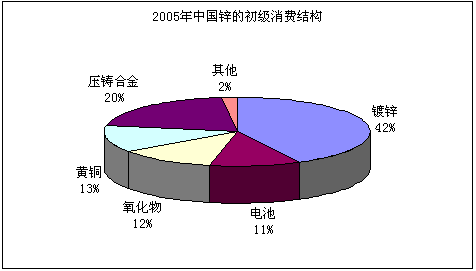Natural attribute and application
Metallic zinc, chemical symbol Zn, atomic weight 65.4, melting point 419.73 ℃, boiling point 907 ℃. Zinc is a silvery white metal with bluish gray, and its fresh section presents a crystal shape with metallic luster. Zinc is one of the commonly used non-ferrous metals, and its output and consumption are only second to copper and aluminum.
Zinc metal has good corrosion resistance, ductility and fluidity, and is often used as the protective layer of steel, such as galvanized sheet and pipe. It can be made into alloys with better physical and chemical properties with a variety of metals, and is widely used in construction, automobile, electromechanical, chemical and other fields.

Data source: Antaike
From the perspective of the primary consumption structure of zinc in China, zinc plating accounts for 42%, dry batteries for 11%, cast zinc alloys for 20%, copper alloys for 13%, and oxides for 12%. Widely used in construction (40%), transportation (8%), light industry (15%), daily hardware (16%), household appliances (5%), electricity (4%), telecommunications (4%), infrastructure and others (9%).

Data source: Antaike
Main uses of zinc
Zinc is an important raw material of nonferrous metals. At present, zinc is second only to copper and aluminum in the consumption of nonferrous metals. Zinc has good calendering, wear resistance and corrosion resistance, and can be used with a variety of metals to make alloys with better physical and chemical properties. The main products produced by primary zinc enterprises are: metal zinc, zinc based alloys, zinc oxide. These products are widely used, mainly in the following aspects:
(1) Galvanizing
The coating used for anti-corrosion (such as galvanized sheet) is widely used in automobile, construction, shipbuilding, light industry and other industries, accounting for about 46% of the zinc consumption.
Zinc has excellent atmospheric corrosion resistance, so it is mainly used for steel products And surface coating of steel structural parts. After the surface of hot dip galvanized alloy for electroplating is oxidized, a uniform and fine layer of basic zinc carbonate ZnCO3Zn (OH) 2 oxide film protection layer will be formed, which can also prevent the growth of mold. Because zinc alloy plate has good resistance to atmospheric corrosion, in recent years, western countries have also begun to try to use it directly as roof covering material. The service life of zinc alloy plate as roof covering material can be as long as 120-140 years, and it can be recycled. The service life of galvanized iron plate as roof covering material is generally 5-10 years.
(2) Manufacture of copper alloy materials (such as brass)
It is used in automobile manufacturing and machinery industry, accounting for about 15%.
Zinc has suitable mechanical properties. The strength and hardness of zinc itself are not high. After the addition of aluminum, copper and other alloy elements, its strength and hardness are greatly improved. Especially with the appearance of zinc copper titanium alloy, its comprehensive mechanical properties have approached or reached the level of aluminum alloy, brass and gray cast iron, and its creep resistance has also been greatly improved. Therefore, zinc copper titanium alloy has been widely used in hardware production.
(3) For casting zinc alloy
It is mainly die casting, which is used in automobile, light industry and other industries, accounting for about 15%.
Many zinc alloys have excellent processability, and the pass processing rate can reach 60% - 80%. With superior medium pressure performance, it can be used for deep drawing, and has self-lubricating property, which extends the service life of the mold. It can be welded by brazing or resistance welding or electric arc welding (in helium). The surface can be plated and painted, and has good cutting performance. It has superior superplasticity under certain conditions.
In addition, zinc has good electromagnetic resistance. The conductivity of zinc is 29% of the standard electrical copper. In the case of radio frequency interference, zinc plate is a very effective shielding material. At the same time, because zinc is non-magnetic, it is suitable to be used as the material of instrument parts, instrument housing and coins. At the same time, zinc itself and other metals will not collide with sparks, so it is suitable for underground explosion-proof equipment.
(4) For manufacturing zinc oxide
Widely used rubber , coating, enamel, medicine, printing, fiber and other industries, accounting for about 11%.
(5) It is used to manufacture dry batteries in the form of zinc cake and zinc plate, accounting for about 13%.
Zinc has appropriate chemical properties. Zinc can interact with NH4CI to release H+positive ions. The zinc manganese dioxide battery makes use of this feature of zinc. The shell of the battery is made of zinc alloy, which is not only the container of the battery electrolyte, but also participates in the battery reaction to form the anode of the battery. Its performance is also widely used in the pharmaceutical industry.


